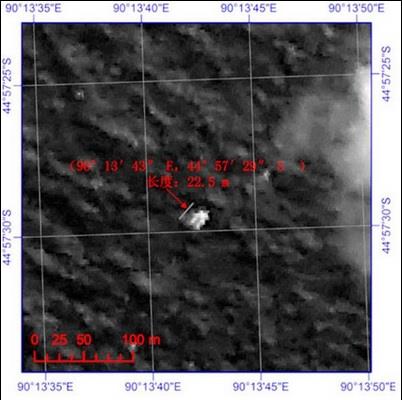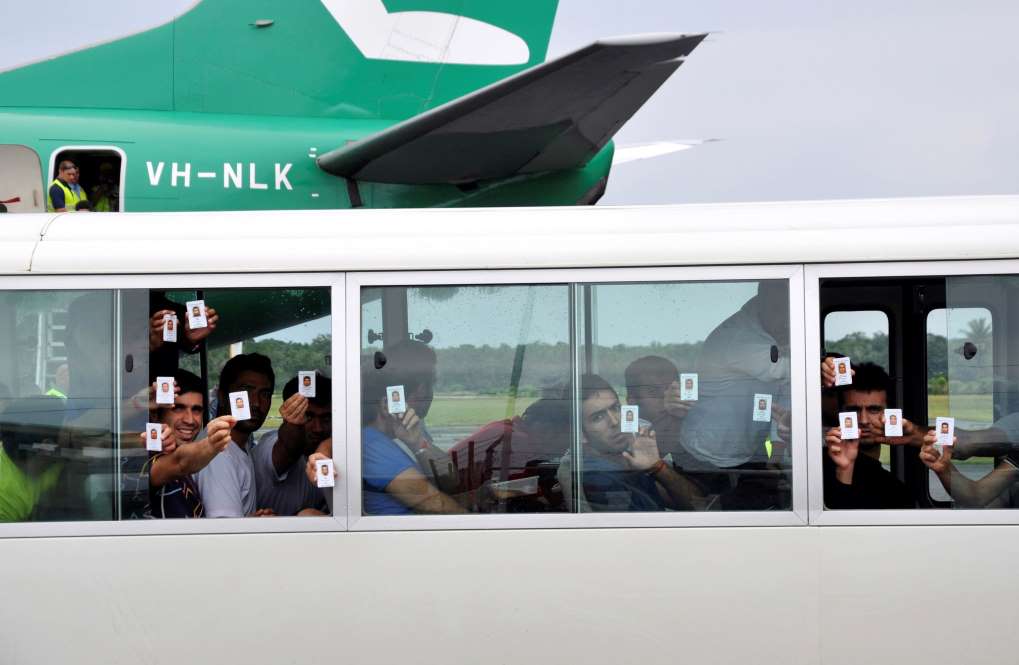March 22, 2014
PERTH, Australia: China released on Saturday a new satellite image of a large floating object possibly linked to missing Malaysian Flight MH370, boosting search efforts as anger with the pace of the operation boiled over among Chinese relatives in Beijing.

March 22, 2014
PERTH, Australia: China released on Saturday a new satellite image of a large floating object possibly linked to missing Malaysian Flight MH370, boosting search efforts as anger with the pace of the operation boiled over among Chinese relatives in Beijing.

Family members of passengers onboard Malaysia jet raise their fists as they shout ''return our families'' to protest against the lack of new information after a routine briefing given by Malaysia's government and military representatives at Lido Hotel in Beijing.
The grainy photo taken on March 18 released by the State Administration of Science Technology and Industry showed an object measuring 22.5 metres by 13 metres (74 by 43 feet) in the southern Indian Ocean.
The location was given as just 120 kilometres (75 miles) distant from where March 16 satellite images — released by Australia on Thursday — had detected two pieces of possible wreckage in a remote, storm-swept stretch of ocean around 2,500 kilometres southwest of Perth.
Six planes, including four Orion anti-submarine aircraft packed with state-of-the-art surveillance equipment, scoured the area for a third straight day without success Saturday.
The emergence of the new photo was announced in Kuala Lumpur by Malaysian transport minister, Hishammuddin Hussein, who was a handed a note during his daily press briefing on the international search for MH370 which vanished two weeks ago.
A visibly animated Hishammuddin wrapped up the briefing early "to follow this lead".
Chinese, British and Australian naval ships are already steaming to the search area and the new image will provide welcome backing for the decision to deploy so many resources without confirmation that the objects are pieces of wreckage.
Two-thirds of the 227 passengers on board the missing plane were Chinese and growing anger among their family members over Malaysia's handling of the crisis exploded during a meeting with Malaysian officials at a Beijing hotel.
Police were forced to intervene as relatives rushed towards the officials, demanding answers which they accuse the Malaysians of withholding.
"Government of Malaysia, tell us the truth! Give us back our loved ones!" they shouted.
After the police stepped in, the Malaysian officials left the room. "We can't bear it any longer," one of the relatives said later. "They're offering us compensation, but we've lost our entire families. Before he cut short his briefing in Kuala Lumpur, Hishammuddin promised to continue engaging with the families despite the growing tensions.
"I know this roller coaster has been incredibly hard for everyone, especially for the families," he said.
In Perth, Australian deputy PM Warren Truss vowed there would be no let up in the search.
"We intend to … search until we are absolutely satisfied that further searching would be futile and that day is not in sight," Truss said.
"At this stage we are planning to continue indefinitely." The distance from Australia's west coast allows the Orions only about two hours of actual search time before they must turn around with enough fuel to get back to Perth.
MH370 dropped off civilian radar on March 8 en route from Kuala Lumpur to Beijing, and two weeks later Malaysian investigators still believe it was "deliberately diverted" by someone on board.
Three scenarios have gained particular traction: hijacking, pilot sabotage, and a sudden mid-air crisis that incapacitated the flight crew and left the plane to fly on auto-pilot for several hours until it ran out of fuel and crashed.

A satellite image taken on March 18, 2014 of an object spotted in the southern Indian Ocean by the Gaofen-1 high-resolution optical Earth observation satellite CNSA (China National Space Administration). Chinese satellites have spotted the new object in the southern Indian Ocean that could be wreckage from the missing Malaysia Airlines Flight MH370 carrying 239 people, and ships are on their way to investigate, China and Malaysia said on Saturday.
Finding wreckage in the remote southern Indian Ocean would undermine the hijacking theory, which many of the relatives continue to cling to.
Sarah Bajc, the partner of American passenger Philip Wood, voiced concern that the sudden focus on a particular section of the Indian Ocean was happening at the expense of a land search along a northern route the plane may have taken over South and Central Asia.
"I believe, and I think many people believe, the passengers are being held for some other purpose. But so far that doesn't seem to be listened to," Bajc told CNN
"If there's a chance it was taken by an abductor of some sort, then we should be putting at least some of our resources towards looking on land," she added.
The search for MH370 has become one of the longest — and certainly largest — in modern aviation history.
Expectations based on advances in technology, coupled with the modern era's relentless 24-hour media coverage, would seem to rule out public acceptance of the idea that the aircraft may never be found.
Scott Hamilton, managing director of US-based aviation consultancy Leeham Co., said the investigation would simply have to continue for as long as it takes.
"This is, in all probability, a criminal act, and thereby presumed murder of more than 230 people," Hamilton said.
"Worse, if this is some kind of terror event that is a precursor to something bigger in the future, authorities will presumably do all they can to make this determination and work to prevent it — whatever 'it' is," he added.
Malaysia has asked the FBI to help recover data it said was deleted from a home flight simulator belonging to the plane's chief pilot, Captain Zaharie Ahmad Shah, but otherwise no evidence has emerged to implicate him.
Courtesy: AFP
















































































































